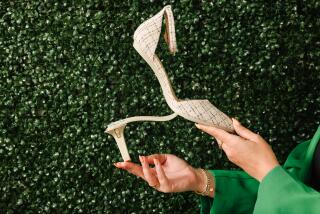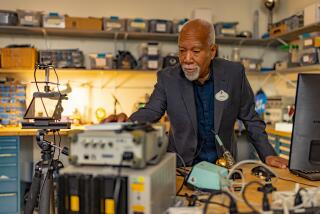Bring on the next big thing
A.J. Khubani turns that old saw about the world beating a path to your door if you invent a better mousetrap upside down.
FOR THE RECORD:
Inventors Day: A column in the March 7 Business section about inventors who gathered to show their wizardry to a panel headed by infomercial marketer A.J. Khubani said Scott Heim runs Oregon Freeze Dry Inc. His company, which is based in Oregon, is called Dry Inc. â
Inventors beat a path to his door. One day last week they arrived in waves: inventors of new takes on dog leashes, floor mats, home exercise devices, skin creams, pillows, umbrellas, coffee mugs, kitty litter strainers, eyelash curlers.
Early Wednesday morning, 44 inventors crammed into a conference room and lined up in the hallway on an upper floor of the Los Angeles Airport Marriott. In this case, the term âinventorâ doesnât give the whole picture -- think âpurveyors of would-be TV infomercial productsâ to complete the description.
Their hope was to receive the Nod That Leads To Wealth from Khubani, the founder and chief executive of Telebrands, one of the largest infomercial marketers in the country. Khubaniâs quest for the next big thing to be hawked by supercaffeinated pitchmen on TV was the rationale for Inventors Day, the event he sponsored at the Marriott.
Far from home
Telebrands has been holding these events every couple of months since May, but this was the first one it scheduled outside its headquarters in Fairfield, N.J.
The format was, unsurprisingly, extremely televisual: Behind a long table sat a panel of four judges -- Khubani and his wife, Poonam; Nancy Lazkani, the owner of a Van Nuys direct marketing firm; and Tommy Zarzecki, Telebrandsâ âofficial blogger.â
Looking on were a film crew shooting a demo for a possible reality show, a feature reporter for NBCâs âTodayâ show, and a few others from the local press, like me.
The inventors each got five minutes to demonstrate their ideas, preferably with a working prototype, and field a few gentle questions from the judges -- how they got their idea, whether theyâve been selling the product at trade shows or online, etc.
Khubani managed to hear out dozens of contestants with remarkable equanimity, never displaying boredom or impatience no matter how bizarre or comic the pitch. The very first pitch of Inventorâs Day came from a man from Georgia selling a âdo-it-yourself face lift,â a cream he said heâd been marketing to women âfor over three years -- with no side effects!â
âThis is just like âAmerican Idol,â â gushed Andrea Pass, the companyâs publicist. Well, maybe with a bit of âLetâs Make a Dealâ thrown in. Some inventors came in costume, including two women from Schaumburg, Ill., who dressed in matching pink jackets to promote a gizmo to foil purse snatchers by chaining your handbag to the chair youâve hung it on.
An in-air cocoon
Then there was Chad Hassell of Salt Lake City, who wandered the hallway draped in his âCozy Traveler,â a body-length blanket hooked to a plump neck pillow to provide head-and-body comfort on cramped and chilly airplanes.
The get-up made Hassell look a bit like Ming the Merciless aproned up for a spot of backyard barbecuing, but thatâs not to say the product might not work as advertised.
The people waiting their turn in the dock represented a fairly wide range of American Inventordom. Most had been pre-screened by Telebrands and invited to come to the event -- at their own expense, naturally. But several were walk-ons arriving unexpectedly, evidently inspired by an interview Khubani gave a local radio station earlier in the week.
At one end of the spectrum were those with a germ of an idea looking for someone to make it real. For example, Karen Wilson, 55, of Coral Springs, Fla., who dubs her product âThe Pillow Youâve Always Dreamed Of.â This, she told me, is an inflatable, ergonomically shaped pillow with a built-in pocket to hold a hot/cold gel pack.
âItâs better than all the other pillows out there,â she assured me. The problem was that it has to be airtight, and she hasnât been able to get the pieces glued just right. âIâve got it all figured out, but I need to get it manufactured,â she said.
At the other end was Scott Heim, 49, a former marketing executive at Kimberly-Clark and DowBrands (where he managed the Ziploc brand), who runs Oregon Freeze Dry Inc. His companyâs product is a disposable cloth that dry-cleans your garments when itâs tossed in your home dryer with them.
The firmâs Dry Cleanerâs Secret has been on supermarket and drugstore shelves for years, but Heim told me heâs been body-checked away from mega-retailers Wal-Mart and Target by the machinations of big consumer-goods companies, which ferociously protect shelf allocations.
His hope was that Telebrands, which gets 90% of its sales from retail chains like those, would take Dry Cleanerâs Secret under its capacious wing. âWal-Mart and Target could double our product overnight,â he said. (Khubani asked Heim to provide him later with some verified sales information.)
Then there were the in-betweeners. Intriguing products like the Alpha Pac, a shoulder harness to which you can clip up to four leashes, allowing you to walk your dogs while carrying grocery bags or wheeling a stroller, without being pulled off your feet when the hounds charge off after the nearest squirrel.
Head-scratchers also turned up, like the Pull4Green travel mug, which is supposed to supplant environmentally incorrect disposable coffee cups but uses disposable cardboard liners that resemble, well, disposable coffee cups. If that reminds you of the counterfeiter who made fake 20-dollar bills by snipping the â$20â off real twenties and gluing the bits to the corners of one-dollar bills, maybe you can figure out why Khubani didnât give it a thumbs up.
Khubani says he expects one or two items shown at the average Inventorâs Day to move up to the test stage; only one in 10 that Telebrands tests, he says, is successful in the marketplace.
âA product has to fit into our specific marketing model,â he says. A good product is easily explainable, solves a simple common problem, is fairly compact for easy shipping and shelf display, and sells for $10 to $20.
Opinions differ
Does it actually have to work? Thatâs a matter of some debate. Some Telebrands goods, like a handle allowing you to swab those hard-to-reach corners of your car windshield (the âWindshield Wonderâ), get pretty high marks on consumer bulletin boards. Others get panned, like a device that supposedly transmits your cellphone signal through your radio but, according to many buyers, produces a lot of static.
Then there are products like the Ab Force, over which the Federal Trade Commission extracted a $7-million settlement in 2008 for the companyâs âunsubstantiated claimsâ that it helped you lose weight, gave you tight abs and served as âan effective alternative to conventional exercise.â By then Telebrands had sold 700,000 of the things.
Michael Hiltzikâs column appears Sundays and Wednesdays. Reach him at [email protected], read past columns at www.latimes.com/hiltzik, and follow @latimeshiltzik on Twitter.
More to Read
Inside the business of entertainment
The Wide Shot brings you news, analysis and insights on everything from streaming wars to production â and what it all means for the future.
You may occasionally receive promotional content from the Los Angeles Times.











